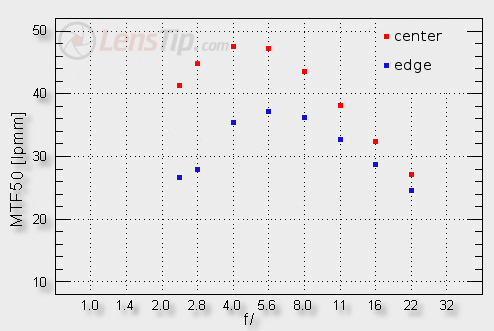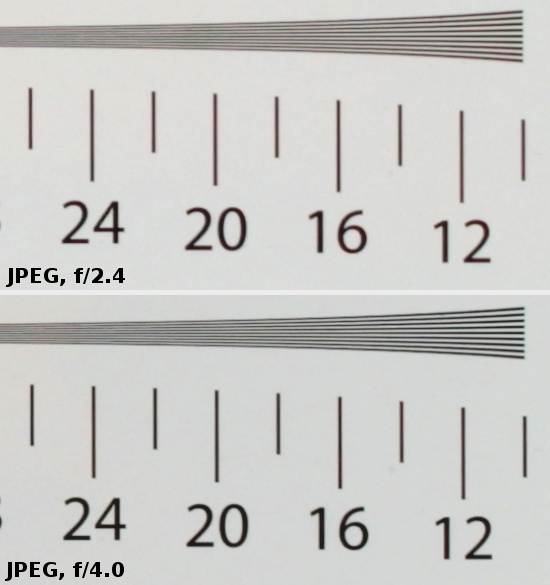Samsung NX 16 mm f/2.4
4. Image resolution
Let’s see how the achievements of the Samsung NX 16 MM F/2.4 compare here. A graph below shows its performance in the frame center and on its edge.

Please Support UsIf you enjoy our reviews and articles, and you want us to continue our work please, support our website by donating through PayPal. The funds are going to be used for paying our editorial team, renting servers, and equipping our testing studio; only that way we will be able to continue providing you interesting content for free. |
- - - - - - - - - - - - - - - - - - - - - - - - - - - - - - - - - - - - - - - - - - - - - - - -
When it comes to the centre of the frame, it would be difficult to carp about anything. Even at the maximum relative aperture the image quality is good, as the MTFs exceed a level of 40 lpmm. Here the Samsung outperforms significantly the rival Sony 2.8/16 which, being slower, at the maximum relative aperture had very weak results. The highest values are reached by f/4.0-5.6 where the tested Samsung gets to almost 48 lpmm. These results are perhaps not as good as those of the NX 2/30 model but wide-angle ‘pancakes’ rarely break resolution records. Neither the Sony ‘pancake’ or the Panasonic 2.5/14 and 1.7/20 managed to do that.
When it comes to the frame edge the Samsung is better than the Sony once again. The Sony got to the decency level only after stopping down to near f/5.6, the Samsung is fully useful from f/4.0. You can complain a bit about the performance by f/2.4 and f/2.8 but you should remember that we deal here with a small ‘pancake’ with equally small elements – you shouldn’t expect any miracles here. If the rear element is 14 mm in diameter it is very difficult to get any telecentricity and, with such angles of view, near the maximum relative aperture the corners have to be ‘soft’.
The crops of the centre of our resolution testing chart were taken from JPEG files (with the lowest sharpening level available, which, in the Samsung NX10, is really low), saved along with RAW files, used for the analysis above.
 |
One untypical issue remains to be explained here. You can find information on the Internet that, while this 16 mm Samsung lens cooperates well with such cameras as the NX10, the NX11 or the NX100, it performs much weaker in the corners of a more densely packed sensor of the NX200. We decided to check that as well. Using the NX10 and the NX200 we took photos by f/2.4 and f/4.0 apertures and cropped one part from the bottom right-hand corner. Both these crops are presented below.
| JPEG | |||
|
|
|
|
|
|
|

|

|
|
|
|

|

|
|
When it comes to the f/2.4 aperture the image quality is low in the case of both cameras – in perfect accordance with our resolution test by the way. By f/4.0 the number of details increases and the photo taken with the NX200 seems to be sharper. It would be difficult to connect it with a real resolution increase; it seems a bit higher degree of sharpening is responsible here as the minimum sharpening level of the NX200 is a bit higher than that of the NX10 (such an effect was described in reviews of those two cameras). We cannot confirm the information found on the Internet at all. Our specimen of the 16 mm lens performed on the edge of the frame more or less the same with both bodies, used in this comparison.
It is difficult to say what was the cause of such an untypical performance, described on the Internet. There might be several reasons – say, comparing images with a different sharpening level. It cannot be excluded that cameras with different firmware correct the aberrations in a different way and, after all, that correction can’t be just switched off (more in the following chapters). Of course different levels of correction can influence the resolution of a photo in a different manner.






